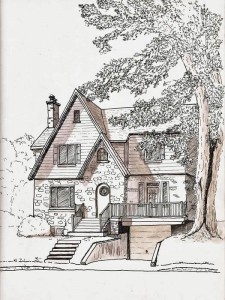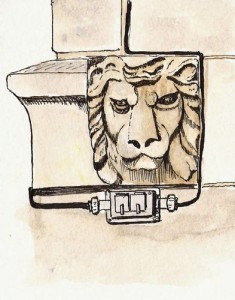Larry D. Marshall's Blog, page 98
October 2, 2013
Another Trip To Ile D’Orleans – Pt 1
I finally got out sketching and it was a fantastic day. Unseasonably warm and not much wind so I headed back to Ile d’Orleans where I sketched and froze the last time I was on the island. This steeple is attached to a church that’s on the eastern end of the island, in the town of St. Jean. Its bright orange roof must serve as a visible beacon for the cargo ships that come from the Atlantic and are making their way towards Quebec City.
The church is across the street from a place that sells great brioche and coffee. Last time I was there they’d lost electricity because of high winds so there was no coffee but it’s a regular stop for me when I get out to the island.

Moleskine watercolor (3×5), Pilot G-TEC-C3 pen
Once I sketched the steeple, I walked across the street to get my coffee and danish and this time it was closed because, it seems, it is closed on Mondays. Disappointment didn’t last too long, though. They have a lot of chairs in a very pleasant garden area so I took one and set it up so that I could sketch one of the unique lamp posts in St. Jean.

Moleskine watercolor (3×5), Pilot G-TEC-C3 pen
Have you noticed that some sketches are more ‘relaxed’ than others as you do them? That’s certainly the case for me. In this case, I’d just finished staring hard at all the detail in the steeple and mostly just wanted to sit. Because of the situation, I was sitting on a gorgeous ‘throne’ in the form of a sculpted, cast-iron chair, with grass beneath my feet. The temperature was perfect, the sun was shining, and I was sitting in the shade. If I’d gotten any more relaxed I would have fallen asleep. The worst day sketching is a good day but some are better than others.
September 26, 2013
Location Sketching On Ile d’Orleans
along with Colonel Jackson
down the mighty Mississip.
We took a little bacon,
and we took a little beans,
and we fought the bloody British
in a town called New Orleans.”
These lyrics, sung long ago by Johnny Horton, tell of the final battle of the War of 1812 where Americans defeated a British invasion force. The song was a big hit when I was a kid and every time I head to Quebec’s Ile d’Orleans that song rattles around in my brain. Truth is, the French had their own battle against a British invasion and Wolfe, the leader of that invasion force, nearly died when his ship ran aground just off the coast of the island, and within cannon distance of the French forces.
But war is not the topic of today’s post. Rather, it is about a trip I took recently to Ile d’Orleans to sketch. I use ‘trip’ loosely as it takes all of fifteen minutes to get there as you can see Ile d’Orleans from Quebec City and vice versa. Going to the mall takes longer.
Ile d’Orleans is a big island in the St. Lawrence River, just as it widens from its narrowest point, at Quebec City, on its way to the Atlantic Ocean. There are six municipalities on the island, though I have a hard time determining where one begins and another ends. What I know is that the island is gorgeous and I love my time there. A lot of vegetable and fruit growing goes on, and it’s a very popular tourist location.
I’ve sketched on the island but I’ve never gone there alone, with the singular goal of sketching. This day, I was on a mission. The sun was out, I had sketchbooks a plenty, and I’d arranged to have our car for the day. I arrived on the island about 8:45 and drove to the backside of the island to a pier that juts out into the St. Lawrence. I discovered it when I was with my buddy Nicolas and we were like a couple kids, chasing the Queen Elizabeth II as she passed along the southern coast of the island on her approach to Quebec City.

Moleskine watercolor (3×5), Pilot Prera, Platinum Carbon Black
I walked out onto the pier, set up my stool and began sketching. You know what? Sun doesn’t help much when there’s a 20-30km/h wind blowing across a large body of water and its hyper-cooled air is cutting you in half. I was COLD!!! At one point I went back and sat in the car for a while to warm up but, finally I finished the sketch. I was a bit too much in a hurry, do you blame me, and ended up with some paint blooms in the foliage because my previous wash wasn’t yet dry, but them’s the breaks.
I was really cold when I finished and so headed for a place I knew that serves wonderful brioche and good, hot coffee. Unfortunately, the winds had blown out their electricity – no coffee. So, I bought a brioche and sat in the car, with the heater running, to warm up.
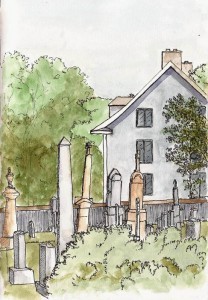
Stillman & Birn Zeta (5×8), Pilot Prera, Platinum Carbon Black
Across the street from the café is a church and a cemetery. I keep telling myself that I should draw more in cemeteries as I love the shapes of the grave stones and their helter-skelter orientations, probably caused by the annual freezing and thawing of the ground. I found a view I liked, went back to the car to get my stuff and I was soon sitting in the cemetery sketching. This was a little better as there was a stone wall around the area that broke some of the wind. I was only semi-frozen when I finished this one.
I was getting ready to leave. Actually I was turning around in the church parking lot when my eye caught a “Privé” sign and a lamp post. I love to have such things in my sketches and so I decided to sketch this scene. Once again, however, I would be fully-exposed to that darn wind coming off the St. Lawrence. I am old but even I can learn new tricks. I positioned the car so I could sketch while sitting inside. About halfway through I was wishing I had a hacksaw to eliminate the steering wheel but it worked out ok once I got the hang of it.

Stillman & Birn Zeta (5×8), Pilot Prera, Platinum Carbon Black
There’s so much to sketch on the island that I could go there every day and not get bored. In another couple weeks the trees should be putting on their annual ‘fall colors’ light show and I’m going back ‘real soon.’
September 24, 2013
Sketching On Location – Matthew Brehm
I have few inherent talents. I can’t throw a ball 100mph. I can’t devise new laws of physics. But I’ve got an intense curiosity and my persistence factor is off the charts. .
I have come to art late in life and my solution to the ‘you’re old; you don’t have much time’ dilemma has been to read everything and anything about drawing, coupled with a whole lot of doing. Nick Meglin (Drawing From Within) is right when he says that the book that will teach you the most about drawing is your sketchbook.
But there are insights one can glean from books and those ideas and techniques can have small or large effects on how quickly you can progress. Besides, I’m an ex-scientist and that translates into a view that understanding what smart people think is good for me.
A few things have come from wandering through dozens of ‘drawing books’ written from the 1800s onward. It’s clear there is a difference between how drawing was once taught and how it’s being taught now. If one reads 19th Century drawing texts one is taught to draw everything and to do it from observation, probably because most jobs for artists actually required that skill. Modern texts from the art world all seem to assume that artists draw naked people or draw from their imagination in a studio. It’s barely acknowledged that anyone goes out and draws planes, trains and automobiles anymore and, if one looks at the art hangs as ‘modern art’ in museums, they don’t. Deanna Petherbridge suggests, in her Primacy of Drawing, that a renewed interest in representational art is causing a renewed interest in drawing. I hope she’s correct.
Another thing I’ve noticed is that the sketching world is full of very good sketchers, drawing from observation. They are masters of their craft; they are my heros. A surprising number of them are graphics illustrators, comic book and animation artists and ARCHITECTS! Liz Steel, Gerard Michel, Tia Boom, Matthew Brehm, and my buddy Yvan Breton all come from architectural backgrounds. And when you talk with them it’s easy to see why. Their schooling required them to carry sketchbooks and draw everything and anything on location.
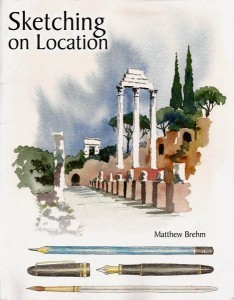 I’ve finally been able to buy a copy of Matthew Brehm’s book Sketching on Location and it is one of the few books on location sketching I’ve seen. And is it ever good. I reviewed Freehand Sketching by Paul Laseau (another architect) and underscored his distinction between location sketching and sketching from photos/imagination. Brehm makes the distinction and provides an extensive toolkit for those wanting to draw from observation. He begins his book thus:
I’ve finally been able to buy a copy of Matthew Brehm’s book Sketching on Location and it is one of the few books on location sketching I’ve seen. And is it ever good. I reviewed Freehand Sketching by Paul Laseau (another architect) and underscored his distinction between location sketching and sketching from photos/imagination. Brehm makes the distinction and provides an extensive toolkit for those wanting to draw from observation. He begins his book thus:
The differences between drawing from observation and drawing in a studio are greater than most seem to understand. The best example of this is “perspective”, a term used by artists for everything having to do with showing depth on a 2D surface, it seems. A quick scan of art books can yield authors saying they perspective to create perspective. But mostly the word is associated with a lot of geometry, mind-boggling geometry. The result are people who say “I can’t draw buildings because I’m not good at perspective” but who can draw gorgeous figures, flowers, etc. where the very same “perspective” exists.
And why does this view exist? Because nobody ever told artists the Catch-22 of linear perspective when applied to location sketching. If you’re going to determine the vanishing point for a building wall, you’ve got to ‘see’ the angles, at least the top and bottom horizontals before a vanishing point can be determined. If you can see the angle, why do you need the vanishing point? While it’s useful to understand the basics of linear perspective, when doing observational drawing the building is right in front of you. You don’t have to make up the angles; you just have to see them.
Brehm uses the term ‘composition’ as a way to build connections between objects, determine the observed angles, sizes and to identify convergences that make it much easier to capture a scene that is in front of you. I know these methods as ‘scaffolding’ but the ‘rose by any other name…’ cliché applies here. He does discuss linear perspective as well, but from the point of view of its more limited uses in observational drawing.
These sections of Brehm’s book alone are enough to change how you approach observational drawing. But his approach to other, more typical drawing subjects (eg – value, color) all emphasize, as one might expect, how they are used by the observational sketcher rather than a studio artist. I highly recommend this book to anyone who is interested in drawing real things, in real places. This book will help you almost as much as your sketchbook.
[image error]
September 21, 2013
It’s My Birthday!!!
Have you noticed that as you get older the time between your birthdays gets shorter? Have you also noticed that you’re not as thrilled by them as you once were? Maybe it’s just me. I still act like a kid but I’m old and getting older doesn’t impress me much.
 But I just had a birthday that I liked a lot. I’m now a two-year-old sketcher. That’s right, near the end of August 2011, I discovered Danny Gregory’s books and his notion that doing art wasn’t about talent and that it wasn’t about creating great art.
But I just had a birthday that I liked a lot. I’m now a two-year-old sketcher. That’s right, near the end of August 2011, I discovered Danny Gregory’s books and his notion that doing art wasn’t about talent and that it wasn’t about creating great art.
He had the audacity to suggest that anyone could enjoy doing art because the process of doing art, not the end product, is what’s important. As one who has always tried to be creative, but also one who was told he had no ‘talent’ for art, this came as a revelation to me. It was a life-changing event.
And so I started drawing cubes. I’m an analytical type, an ex-scientist, so I felt that if I was going to draw, I needed to start with boxes. In hindsight, I’m glad I did. I drew a gazillion of them. I’d draw one and then try to draw another rotated a bit in one direction of the other from the original. It seemed I was buying a new watercolor book every other day, determined that I’d learn to paint.
But I learned something very quickly. Most watercolor books go like this:
1) Start with a sketch…
2) add a wash…..
3) do something else…
4) finish up with details.
And, to me, this is akin to saying “Want to decorate your own house? Ok, first do all the carpentry and plumbing” but it is the standard way that watercolor books are presented. If you can’t draw, they’re all pretty useless in my opinion.
So I decided that I would spend the first year “learning to draw”, whatever that meant to me at the time. I’m still trying to learn to draw and now figure I’m not going to master it anytime soon. But I do believe that by emphasizing drawing over painting I did myself a great service. For the past couple years I’ve used watercolors but mostly like crayons, filling in areas in my pen and ink sketches as a 5-year old does in their coloring books.
I wish I could share with you some of my early attempts at drawing, but I cannot. All my early sketching was done on photocopy paper and ended up in the trash can. I saw no need to keep any of it, at least until I mentioned this to more seasoned sketchers in an Internet forum. There seemed to be a collective gasp, followed by “Don’t do that. You’ll want to look back some day and evaluate your progress.” They were right and that day was today. I guess that advice came in October 2011 as from then on, everything is in sketchbooks, the good, the bad, and the ugly.
Here was my first attempt at a ‘real’ sketch. I did it from a photo as in October of 2011 I ‘knew’ I’d be eaten alive by passers-by if I dared sketch on location. At the time I was pretty happy with it. I guess I still am given that only a month prior I was struggling to draw cubes (grin).
 But, since then I’ve filled a sketchbook or three. I’ve become quite passionate about urban sketching. I carry sketchbooks with me wherever I go and I sketch constantly, or so it seems. I can’t seem to get enough. While I’ve got a lot to learn about art in general, and watercolors in particular, I’m sure having a lot of fun and that’s what art is supposed to be all about. Just ask Danny Gregory.
But, since then I’ve filled a sketchbook or three. I’ve become quite passionate about urban sketching. I carry sketchbooks with me wherever I go and I sketch constantly, or so it seems. I can’t seem to get enough. While I’ve got a lot to learn about art in general, and watercolors in particular, I’m sure having a lot of fun and that’s what art is supposed to be all about. Just ask Danny Gregory.
September 19, 2013
Le Carnet Des Escaliers De Quebec
Sometimes it seems there is a gap between the art world and the exploding popularity occurring in the sketching world. Regularly we hear people define ‘sketch’ as an ‘unfinished work’, a definition that might have been fine when Monet was noodling his ideas about lily pads. But this is not what modern nature sketchers, urban sketchers, travel journalists, etc. are doing. Our sketches are finished works and they’re ending up on stamps and in books. They’re being sold, either as originals or as prints.
Sketching has become a representational art form unto itself. There are new books on sketching or containing sketches being released so regularly that it’s hard to keep up with them. Typically modern sketches are done in sketchbooks, in limited periods of time. Often the artist is sitting on a tripod stool, on location, possibly chatting with passers-by. For most sketchers, their emphasis has shifted from the creation of art to hang on walls to simply enjoying the process of art. Some sketch with precision. Others sketch in very loose fashion. Some border on doing caricatures of their world. Somehow, in spite of these different approaches, there is a unity in what sketchers do, mostly related to the process of doing.
While different from studio art, sketching nevertheless shares many aspects with it and I sometimes lament the fact that so many artists don’t understand, or even know of in this growing part of the art world. But something happened in Quebec City last week that was one of those “we’ve come a long way baby” moments.
 It came in the form of a book launch for a wonderful book titled Le Carnet Des Escaliers De Québec. The book was a collaborative effort organized by Natalie St-Pierre. It contains 180 pages of great sketches that represent the majority of the staircases that exist in Quebec City. As an aside, we have a LOT of them because of the nature of the city, including several containing hundreds of steps. The artists involved were, Natalie, Hugette Asselin, Guylaine Côté, Louise Denault, Magelline Gagnon, Louise Grenier, Sylvie Riverin, Monique Rousseau and Pierre Toupin, the token male in the group. Marie Dagenais wrote the text for the book.
It came in the form of a book launch for a wonderful book titled Le Carnet Des Escaliers De Québec. The book was a collaborative effort organized by Natalie St-Pierre. It contains 180 pages of great sketches that represent the majority of the staircases that exist in Quebec City. As an aside, we have a LOT of them because of the nature of the city, including several containing hundreds of steps. The artists involved were, Natalie, Hugette Asselin, Guylaine Côté, Louise Denault, Magelline Gagnon, Louise Grenier, Sylvie Riverin, Monique Rousseau and Pierre Toupin, the token male in the group. Marie Dagenais wrote the text for the book.
The book is not just a great compilation of sketches, however. It’s truly a tourist guide to the stairways. Maps, beautiful sketches themselves, locate all of the stairways ane descriptions and histories of each stairway provide insights into Quebec and its development.
The quality of the book is sufficient reason to write this post but the book launch says something about just how far the sketching world has come. This launch was held at City Hall. It was an invitation only event and was hosted by the mayor. Now if you live in a small town, you might expect a mayor to host a book launch by a group of locals. But Quebec City has 700,000 people in it; our mayor is a busy guy and yet he spent an hour at the book launch. Roughly 100 people were in attendance and we were served amazing hors d’ouevres and wine, along with great conversations. It was truly an inspired and inspiring gathering.
September 17, 2013
Sketching The Good And The Ugly
I’d arranged to meet sketching buddy Claudette downtown and so it wasn’t completely nuts when I started walking in that direction in spite of the fact that I was walking in a cloud. It wasn’t raining but a mist was collecting on my glasses and clothes. Walking fast beat the cold away, though.
When I met Claudette we sort of looked at each other and both of us were disappointed with the morning. We decided to walk through the old port area looking for something to draw but I think neither of us had our hearts in it. It was pretty miserable, depressing weather and we ended up ready to cancel completely.
Claudette spotted a cast lion that was part of the entrance to a building and as we looked at it we both decided it would be worthy of a sketch. What I saw was how we humans have lost site of esthetics in favor of convenience and modernity, or whatever word you want to use. Someone had destroyed much of the beauty of the lion casting by installing a large electrical plug below it and wrapping a wire up around it. A real artist would probably have drawn the lion, leaving the plug out and ‘improving’ their drawing. I’m more about documenting city life and thought this debauched piece of art could be the subject itself.
I did make the mistake of doing it in too small a format for a shaded pen drawing like this and both the lion and plug suffered from a lack of space for proper shading. Nevertheless, here’s the 3×4 sketch, done in a Moleskine watercolor book. I used my Pilot Prera and Platinum Carbon Black.
September 15, 2013
Thick Lines and Quick Hands
One of the days that I was waiting for my hard drive to arrive it rained. I’m not one for sketching from photos but desperation will drive me to such extremes. My pointy device of choice is a very fine pen and I thought it might be an opportunity to play with pens that produce a heavier line and to use them in a more loose fashion than is my norm.
And so I did some quick sketches in a 3×5 sketchbook. Here are four of them.
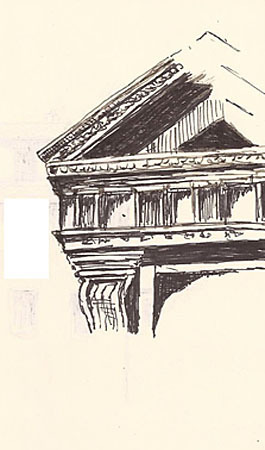
Done with a Hero 578 ‘bent nib’ pen

Done with Sharpie ‘fine’ pen (not marker)

TWSBI Mini w/Platinum Carbon Black

Done with Hero 578 “bent nib” pen in about five minutes.
The next day I went out sketching and continued the experiment. I stopped to pick up a coffee and drew the car across the street.

Done with Hero 578 “bent nib” pen
I was walking along the St. Charles River and decided to stop and sketch these rudbeckia. I’m not much of a flower sketcher but this was fun.
There is a large water regulation reservoir along the banks of the river and I decided to draw it as quickly as I could. I spent less than 15 minutes on it, which is something of a world record for me when it comes to doing buildings. I found the format too small for a building with all those fiddly bits.
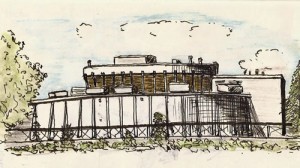
Done with TWSBI Mini w/Platinum Carbon Black
September 13, 2013
A Short Trip To Levis
To both of you who follow this blog, I apologize for my absence. It’s embarrassing to admit but without my laptop I’m dead in the water, and I had a hard drive crash late last week. I got the problem diagnosed by Friday night and then began waiting for a hard drive to arrive in the mail. This is not something you want to be doing as the weekend is just beginning.
So, I scuttled around in my basement and, using ancient computer parts, cobbled together something that looked like a computer and ran almost as fast as an abacus. But it did get me email and limited web access. The drive arrived on Tuesday and I’m now back in business Thank goodness for backups as not much was lost except for a lot of time.

3×5 – Pilot Prera w/Lex Gray ink
During that time I went for a long sketching walk. First stop was to do a quick sketch of sailboats in the harbor. Me and sailboats don’t get along well, mostly because I don’t know much about the rigging and doo-dads that encrust the top surface of sailboats and, from my distant vantage point, these things are hard to make out. But I continue to try and this sketch consumed ten minutes of my time. The fact that I was standing up didn’t help much. I do wish I could get better at sketching while standing 
I wandered around downtown for a while and then got the notion to head to Levis as the sun was out and I always look for an excuse to ride the ferry. On my way over I recalled a small, but rather ornate house I’d seen while I was in Levis sketching with fellow sketcher, Yvan. This is it. The people got sort of faked in using people who were walking by. I ran out of room while adding the woman and I’m not sure she has a left arm. If she does, it’s somewhere in the guy’s right side (grin).

Stillman & Birn Zeta (5×8), Pilot Prera w/ Platinum Carbon Black ink
September 4, 2013
The Variety That Comes From Sketching
If I did a statistical analysis of the my sketching subjects, it would be clear that I’m a building portrait kind of guy. I just love ‘em and enjoy going out, finding them, and sketching them. In fact, being out in the city, sitting on a stool as people walk by, is a major part of what I enjoy about it. I’ve never been much for sketching from photos and this is probably why.
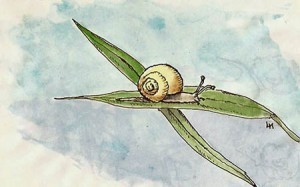
This little guy was hanging out over a path I was walking on in the park. He was actually moving quite quickly, for him, but I had time to do this quick sketch.
I guess it’s true for most people, regardless of how or what kind of art they do; we all have a preferred subject type, whether it is flowers, landscapes, boats, or still lifes. But sketching provides something that other forms do not – the ability to sketch something quickly. This translates into sketchers drawing a much wider variety of things than an artist who must set up an easel and has a mindset of hanging the result on a wall.

I was out for a long walk and sat down in a park. Something suggested that I sketch this basketball hoop that was sitting idle. Definitely a ‘no big deal’ sketch. Took less than ten minutes but it was ten minutes of fun.
We sketchers are happy with these quick sketches, often of subjects that no other group would ever do. We proudly show off our sketch of a garbage can, a fire hydrant or maybe even a dead fish. Why our brains work that way I do not know but I do know that our ability to do this without devoting a lot of time to it is the reason we do it so regularly.

They’re repaving a street near my house and I thought this small roller was unique.
This occurred to me as I was looking at the last few sketches I did in my little Moleskine watercolor book (3×5). Excepting the roller, which took me twenty minutes or so, these sketches were done very quickly, with no particular goal in mind other than to be sketching. All were fun.
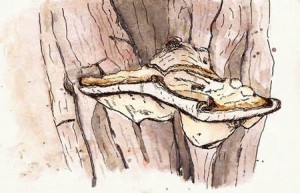
I went birding on a ‘too windy’ day and ended up huddled behind a tree. Did this sketch of a fungus.
September 2, 2013
Stillman & Birn Zeta: A Pen Sketcher’s Dream
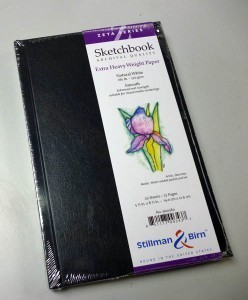 Back in November of 2011 I bought my first Stillman & Birn sketchbook. It was a 5×8, hardcover Alpha-series book. I wrote about the Alpha Series here. In that blog post I said that I liked it very much and I gave several reasons why I felt it outperformed the other sketchbooks I’d tried. I also ran out and bought several more. But as I’d only had it for a short time I added the caveat that “It’s probably premature to draw conclusions that will stick.”
Back in November of 2011 I bought my first Stillman & Birn sketchbook. It was a 5×8, hardcover Alpha-series book. I wrote about the Alpha Series here. In that blog post I said that I liked it very much and I gave several reasons why I felt it outperformed the other sketchbooks I’d tried. I also ran out and bought several more. But as I’d only had it for a short time I added the caveat that “It’s probably premature to draw conclusions that will stick.”
Well, nearly two years and ten S&B sketchbooks in use or filled, I think I can be a bit more definitive…but with another caveat. Stillman & Birn just keeps getting better and better so who knows what ‘best’ will look like in the future.
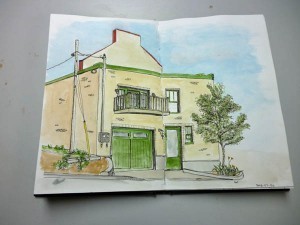
I find the colors are brighter on Zeta paper, probably because they aren’t absorbed into the paper as much. Makes lifting easier as well.
As I filled sketchbooks, I tried the other Stillman & Birn papers. For the pen & ink work I do, the Epsilon sketchbooks are wonderful to draw on. It took me a while to get used to how the smoother paper accepts watercolor as they stay wet longer and sit on the surface more, which is neither good or bad but different from the more absorbent Alpha. The best equivalency I know is to the differences between cold-press and hot-press watercolor papers. Both of these papers are 100lb papers that, while they outperform any papers of this weight I’ve ever used, they still have a tendency to curl somewhat when lots of water are applied. You can see a bit of shadowing if you use both sides of the paper.
And then I tried Beta, S&B’s 180lb paper. This is surfaced very much like a cold-press paper and provides a fantastic surface for watercolors but not as nice as Epsilon for pen use. By the end of the summer of 2012 I wrote a summary post on these different sketchbooks. I was completely hooked on Stillman & Birn papers and their amazing double-stitched bindings which are second to none. But at the time I thought “They need thick “Epsilon” paper.
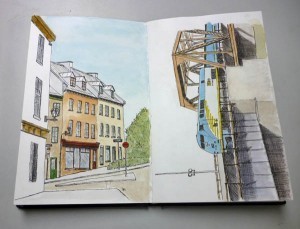
Notice how flat S&B Zeta sketchbooks lay once they’ve been broken in.
And this is the thing about Stillman & Birn. If you dream it, they magically know you were dreaming and they make it. The Zeta sketchbooks were release a few months ago in response to my dream. I’m betting others were dreaming the same thing.
I use several S&B sketchbooks (different sizes and papers) simultaneously and when the Zeta series was released, I immediately started using one. It quickly became a favorite for my kind of sketching (pen/ink and wash). It’s a merging of best of Beta and Epsilon into one paper as it’s 180lb Epsilon paper. I’m working in my second Zeta sketchbook and it’s hard for me to see any reason to use any other, if the size I want is available with this paper.
There lies the rub as I still use Alpha in 4×6 and 10×7 formats. I will likely buy a 7×10 spiral bound Zeta as a substitute for my 10×7 Alphas but, so far, S&B haven’t produced a truly small sketchbook (thin, 3×5) – my current dream. I hope that when they do it will contain Zeta paper (grin).



